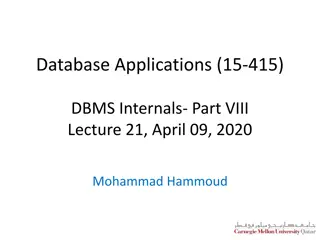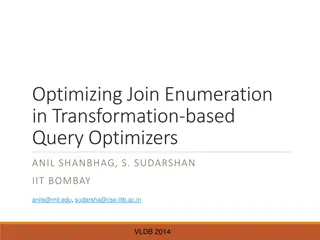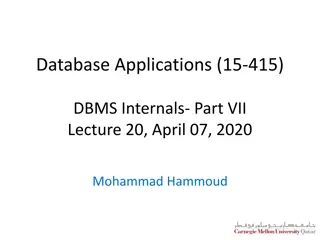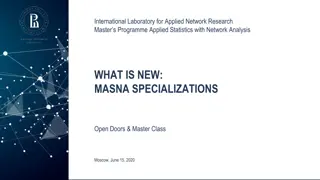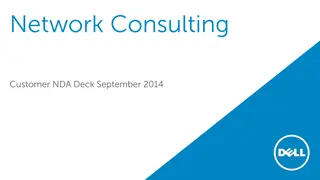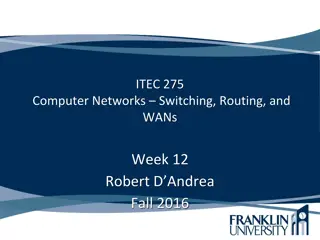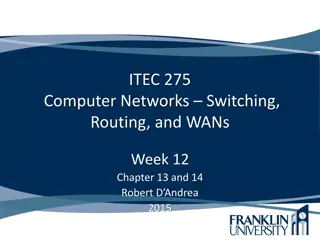Apache MINA: High-performance Network Applications Framework
Apache MINA is a robust framework for building high-performance network applications. With features like non-blocking I/O, event-driven architecture, and enhanced scalability, MINA provides a reliable platform for developing multipurpose infrastructure and networked applications. Its strengths lie i
3 views • 13 slides
Modeling and Generation of Realistic Network Activity Using Non-Negative Matrix Factorization
The GHOST project focuses on the challenges of modeling, analyzing, and generating patterns of network activity. By utilizing Non-Negative Matrix Factorization (NMF), realistic network activity patterns can be created and injected into live wireless networks. Understanding and predicting user behavi
4 views • 28 slides
Automated Anomaly Detection Tool for Network Performance Optimization
Anomaly Detection Tool (ADT) aims to automate the detection of network degradation in a mobile communications network, reducing the time and effort required significantly. By utilizing statistical and machine learning models, ADT can generate anomaly reports efficiently across a large circle network
8 views • 7 slides
The Age-Friendly Network - Empowering Healthy Ageing in North Yorkshire
The Age-Friendly Network, led by Project Coordinator Jeanette Hague, aims to combat ageism, promote intergenerational understanding, and address social perceptions of older individuals in North Yorkshire. The initiative seeks to create an all-inclusive, age-friendly society through active involvemen
1 views • 11 slides
Revolutionizing Network Management with Intent-Based Networking
Explore the concept and benefits of Intent-Based Networking (IBN) in simplifying network configuration and enhancing efficiency. Learn how IBN automates network operations, aligns with business objectives, improves security, and ensures scalability and reliability. Discover the potential of IBN tool
0 views • 14 slides
Understanding Hash Join Algorithm in Database Management Systems
In this lecture, Mohammad Hammoud explores the Hash Join algorithm, a fundamental concept in DBMS query optimization. The algorithm involves partitioning and probing phases, utilizing hash functions to efficiently join relations based on a common attribute. By understanding the intricacies of Hash J
1 views • 41 slides
Understanding Different Types of SQL Joins
Explore the various types of SQL joins such as INNER JOIN, LEFT (OUTER) JOIN, RIGHT (OUTER) JOIN, and FULL (OUTER) JOIN. Learn how each type functions and the syntax for implementing them. Get insights into examples of INNER JOIN and LEFT OUTER JOIN operations to enhance your SQL knowledge.
0 views • 26 slides
Network Compression Techniques: Overview and Practical Issues
Various network compression techniques such as network pruning, knowledge distillation, and parameter quantization are discussed in this content. The importance of pruning redundant weights and neurons in over-parameterized networks is highlighted. Practical issues like weight pruning and neuron pru
0 views • 37 slides
Understanding Joins in DBMS: INNER JOIN, LEFT JOIN, and Examples
Join statements in DBMS, such as INNER JOIN and LEFT JOIN, are used to combine data from multiple tables based on a common field. INNER JOIN selects rows that satisfy a condition from both tables, while LEFT JOIN returns all rows from the left table and matching rows from the right table. Examples i
2 views • 19 slides
Network Slicing with OAI 5G CN Workshop Overview
Overview of Network Slicing with OAI 5G CN workshop focusing on the crucial role of network slicing in realizing the service-oriented 5G vision. This workshop covers topics like multiple logical networks creation on shared infrastructure, different types of network slices, preparation and instantiat
1 views • 6 slides
Network Design Challenges and Solutions in Business Data Communications
Issues in designing a Local Area Network (LAN) include needs analysis, technological design, and cost assessment. The traditional approach involves structured systems analysis, but faces challenges due to rapidly changing technology and increasing network traffic. The Building Blocks Approach recomm
1 views • 20 slides
Understanding 5G RAN Network Slicing and Architecture
Explore the intricate world of 5G Radio Access Network (RAN) and Network Slicing, delving into concepts such as SO Service Orchestrator, SDN-C Service Design, and Core Network Elements. Discover the significance of managing and designing mobile slice services, including eMBB, Massive IoT, and Missio
0 views • 26 slides
Understanding Snort: An Open-Source Network Intrusion Detection System
Snort is an open-source Network Intrusion Detection System (NIDS) developed by Cisco, capable of analyzing network packets to identify suspicious activities. It can function as a packet sniffer, packet logger, or a full-fledged intrusion prevention system. By monitoring and matching network activity
0 views • 23 slides
Data Flows and Network Challenges in Particle Physics Infrastructure
This overview delves into the data flows and network challenges faced in particle physics infrastructure, focusing on the JUNO project. It discusses the process of data reception, storage, and replication across various data centers, highlighting the bidirectional nature of data flows. Additionally,
0 views • 24 slides
Progress of Network Architecture Work in FG IMT-2020
In the Network Architecture Group led by Namseok Ko, significant progress has been made in defining the IMT-2020 architecture. The work has involved gap analysis, draft recommendations, and setting framework and requirements. Phase 1 focused on identifying 19 architectural gaps, such as demands for
1 views • 11 slides
Understanding Interconnection Networks Topology
Exploring the topology of interconnection networks helps determine the arrangement of channels and nodes, impacting network cost, performance, latency, energy consumption, and complexity of implementation. Abstract metrics such as degree, hop count, and network diameter play crucial roles in evaluat
1 views • 56 slides
Transportation Network Modeling and Analysis with C.Coupled SE Platform
This content outlines the features and functionalities of the C.Coupled SE Platform (CSET Platform) developed by the Connetics Transportation Group. It covers aspects such as interface design, inputs merging, purposes, platform development using Cube, TAZs merging, and network attributes. The platfo
0 views • 11 slides
Human Disease Symptom Network: Understanding Disease Relationships Through Symptoms and Genes
The Human Disease Symptom Network (HSDN) is constructed using a large-scale medical bibliographic records database to form a network of human diseases based on symptom similarities. By integrating disease-gene associations and protein-protein interaction data, correlations between symptom similarity
0 views • 37 slides
Introduction to Network Analysis Using .NET
This presentation introduces the concept of network analysis using .NET in the humanities classroom. It provides a template for teaching and adapting network analysis tools for educational purposes. The guide explains the relevance of networks in processing and visualizing data, emphasizing the coll
0 views • 20 slides
Understanding Table Joins in SQL
Exploring various types of table joins in SQL, including Cross Join, Inner Join, Outer Join, and Self Join. Learn how these joins work, when to use them, and see practical examples for better comprehension.
0 views • 22 slides
Understanding SQL JOIN: A Comprehensive Guide
SQL JOIN allows you to merge data from multiple tables in a database, enabling you to access information more efficiently. This comprehensive guide covers the types of JOIN operations available in SQL, such as INNER JOIN, LEFT JOIN, RIGHT JOIN, and FULL JOIN, along with their purposes and practical
0 views • 6 slides
Optimizing Join Enumeration in Transformation-based Query Optimizers
Query optimization plays a crucial role in improving database performance. This paper discusses techniques for optimizing join enumeration in transformation-based query optimizers, focusing on avoiding cross-products in join orders. It explores efficient algorithms for generating cross-product-free
0 views • 18 slides
Understanding SQL Outer Join in Database Queries
SQL Outer Join is a powerful feature that combines data from multiple tables even when there are no exact matches. It includes Left Outer Join and Right Outer Join, allowing you to retrieve all records from one table and matching records from another. The LEFT JOIN keyword fetches all records from t
0 views • 4 slides
Understanding Join Algorithms in Database Systems
This presentation delves into the intricacies of join algorithms in DBMS, focusing on various techniques such as simple nested loops join, block nested loops join, index nested loops join, sort-merge join, and hash join. The importance of optimizing joins to avoid unnecessary cross-products is empha
0 views • 67 slides
Overview of Different Types of SQL Joins
Examine the various types of SQL joins including INNER JOIN, LEFT JOIN, RIGHT JOIN, and FULL JOIN. Understand the differences between these join types and how they retrieve data from multiple tables based on specified conditions. Explore practical examples of joining tables and creating relationship
0 views • 18 slides
TB Nurse Network Updates and Training Opportunities
Stay updated on the latest program updates, webinars, training opportunities, and new products offered by the TB Nurse Network. Get information on upcoming events, including World TB Day, Somos TB meetings for Spanish-speaking patients, and virtual training sessions on TB contact investigation, TB a
0 views • 14 slides
Meridian: An SDN Platform for Cloud Network Services
Meridian is an SDN platform developed by Mohammad Banikazemi, David Olshefski, Anees Shaikh, John Tracey, and GuohuiWang at IBM T. J. Watson Research Center. The platform focuses on providing cloud network services efficiently. It encompasses an architecture that enables faster and more convenient n
0 views • 21 slides
Enhancing Network Security with Software-Defined Snort and OpenFlow
Explore the implementation of Snort, Barnyard, and PulledPork within a Software-Defined Network framework using OpenFlow technology. Learn how these tools enhance network security through intrusion detection engines, rule management, and network traffic control mechanisms. Dive into the architecture
0 views • 15 slides
Understanding Network Metrics Through Centrality Analysis
This presentation introduces network metrics as tools to describe network characteristics and answer important questions. Using centrality metrics as an example, participants learn how to identify the most important nodes in a network based on different criteria such as degree centrality and closene
0 views • 15 slides
Join Your Local HEIW Face-to-Face Events Network
Discover how to stay informed about local face-to-face events organized by HEIW by joining the ytydysgu dental network. Sign in to ytydysgu, navigate to Networks from the Apps section, explore different networks, select your local network, and click join to receive future event information. Stay con
0 views • 6 slides
Understanding Network Analysis: Whole Networks vs. Ego Networks
Explore the differences between Whole Networks and Ego Networks in social network analysis. Whole Networks provide comprehensive information about all nodes and links, enabling the computation of network-level statistics. On the other hand, Ego Networks focus on a sample of nodes, limiting the abili
0 views • 31 slides
MASNA Specializations Master Class & Open Doors Event Moscow, June 15, 2020
Explore MASNA Specializations at the International Laboratory for Applied Network Research through a Master's Programme in Applied Statistics with Network Analysis. Join the upcoming Master Class event in Moscow on June 15, 2020, to discover new opportunities and insights in the field of network ana
1 views • 47 slides
Understanding Network Interference in CS590B/690B Lecture
Delve into the realm of network interference through the CS590B/690B lecture with Phillipa Gill at UMass Amherst. Explore topics such as Internet routing, timing attacks, BGP hijacks, Tor network functionality, relay selection, collusion scenarios, use of guards, web site fingerprinting attacks, tra
0 views • 11 slides
Contribution of HALA Network to ATM Community and SESAR 2020: Achievements and Future Directions
HALA network has been instrumental in fostering research and innovation in the field of automation for ATM systems, providing a platform for knowledge dissemination, collaboration, and advancement. The network has facilitated exploratory research, encouraged young scientists' participation, and crea
0 views • 12 slides
Exploring Network Slicing in Future 5G Networks
The research delves into the design of a 5G-ready architecture known as NFV-based Network Store, aiming to serve as a digital distribution platform for 5G applications. By focusing on network slicing and programmability, the architecture enhances resource efficiency and agility in deploying software
0 views • 17 slides
Network Function Virtualization (NFV) Overview
Network Function Virtualization (NFV) focuses on virtualizing network functions to improve efficiency and reduce costs in network infrastructure. The lecture discusses key readings, devices that compose a network, specialization of devices, benefits of one-device-does-anything approach, and the goal
0 views • 21 slides
Enhancing Network Stability with Network Monitoring Systems
Network monitoring is crucial for efficient management and proactive issue detection in a network environment. Factors influencing an effective network system include choosing the best OEM, SLA agreements, and selecting a reliable System Integrator. Reactive monitoring can lead to financial losses a
0 views • 12 slides
Dell Network Consulting Services Overview
Dell Network Consulting provides expert insights and workshops to enhance your network infrastructure's efficiency. Services include network assessments, topology discovery, traffic analysis, and wireless site assessments. Deliverables include detailed reports, remediation plans, and infrastructure
1 views • 5 slides
Understanding Network Testing in Modern Computing Environments
Today, network connections are essential for various computing tasks, from accessing the internet to setting up local area networks. This article delves into the importance of evaluating existing networks, testing network performance, and ensuring stable connections for optimal user experience. It d
0 views • 46 slides
Understanding Network Testing for Efficient Connectivity
Today, network connections play a vital role in both home and company environments. Ensuring a stable and fast network connection is essential for optimal performance. Various network testing tools are available, including LAN Speed Test and Internet Speed Tracker Extension, to help assess and impro
0 views • 48 slides





